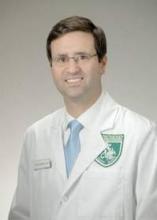Treatment of nine women with metastatic cervical cancer with single infusions of tumor-infiltrating lymphocytes grown out from tumor specimens collected from each patient resulted in two complete responses and one partial response, suggesting that this form of adoptive T-cell therapy could potentially help woman with this type of advanced, solid tumor.
“These results may have important implications for immunotherapy of cervical cancer and for the expanded application of cellular therapy,” wrote Sanja Stevanovic, Ph.D., and her associates in an article published online (J. Clin. Oncol. 2015 [doi:10.1200/JCO.2014.58.9093]).
The findings “advance the field by demonstrating that the durable, complete tumor regression observed with cellular therapy for melanoma and B-cell malignancies is also possible for an epithelial cancer,” said coauthor Dr. Christian S. Hinrichs in an interview. “It is a scientific proof-of-principle. To build on these findings, we are studying the same approach in other HPV- [human papillomavirus] positive cancers including throat and anal cancer. In addition, we are developing T-cell-receptor gene therapies that target the HPV oncoproteins for patients with HPV-positive cancers. A clinical trial using this strategy is now open,” said Dr. Hinrichs, an oncologist in the surgery branch of the U.S. National Cancer Institute in Bethesda, Md.
The role HPV plays in the pathogenesis of cervical cancer gave Dr. Hinrichs and his associates a unique target to exploit for developing adoptive cell therapy (ACT) with tumor-infiltrating lymphocytes (TILs) for women with metastatic cervical cancer.
Immunotherapy “is an attractive strategy for cervical cancers because these tumors nearly universally harbor the HPV E6 and E7 antigens,” they wrote in their report. “The patients in this study had cancers that constitutively expressed the HPV oncoproteins and the administered T cells were selected to target these antigens.”
In fact, they determined that the HPV-reactivity of the TILs that the patients received and the frequency of HPV-reactive T cells in patients’ peripheral blood after treatment correlated with the tumor responses of each patient.
“The main difference between this and other protocols for generating TILs is that we generated multiple, individual TIL cultures from tumor fragments, and tested the T cells in each culture for their reactivity against HPV oncoproteins,” explained Dr. Hinrichs. “The vast majority of other cancer types do not permit this approach because they do not have antigens like the HPV oncoproteins that are almost always expressed by the tumors but absent from healthy tissues.”
The researchers enrolled patients during April 2012-May 2014. Patients averaged 37 years old, and included women with squamous-cell carcinomas, adenocarcinomas, or adenosquamous carcinomas. Seven women had tumors associated with HPV-18, and two had HPV-16 involvement. All patients had multiple sites of distant metastases and had previously received platinum chemotherapy; six had received combination chemotherapy. Patients received a median of 80 x 109 TILs.
The two women with a complete response to their ACT had an ongoing response after 15 and 22 months, respectively. One of these patients had a squamous-cell carcinoma, the other an adenocarcinoma. None of the nine patients showed any acute toxicity related to ACT, nor did they have any autoimmune adverse events. The most common severe toxicities were hematologic and were the expected result of the lymphocyte-depleting conditioning regimen used.
As of April 2015, no ACT has received U.S. Food and Drug Administration approval for routine use. Although many types of ACT for various cancers are under study they all remain investigational, Dr. Hinrichs said. A recent review of ACT by two National Cancer Institute researchers who collaborated on the cervical cancer study highlighted some of the logistical challenges that ACT presents (Science 2015;348:62-8).
ACT “is a more complex approach to the delivery of cancer treatment than many other types of immunotherapy and has often been criticized as impractical and too costly for widespread application,” the review noted. The “highly personalized” treatments involved do not fit the traditional paradigm of off-the-shelf reagents. The authors of the review proposed that one possible solution is to have centralized facilities for producing TILs or other genetically modified lymphocytes that can then provide these personalized cells for ACT performed at local centers.
On Twitter @mitchelzoler



